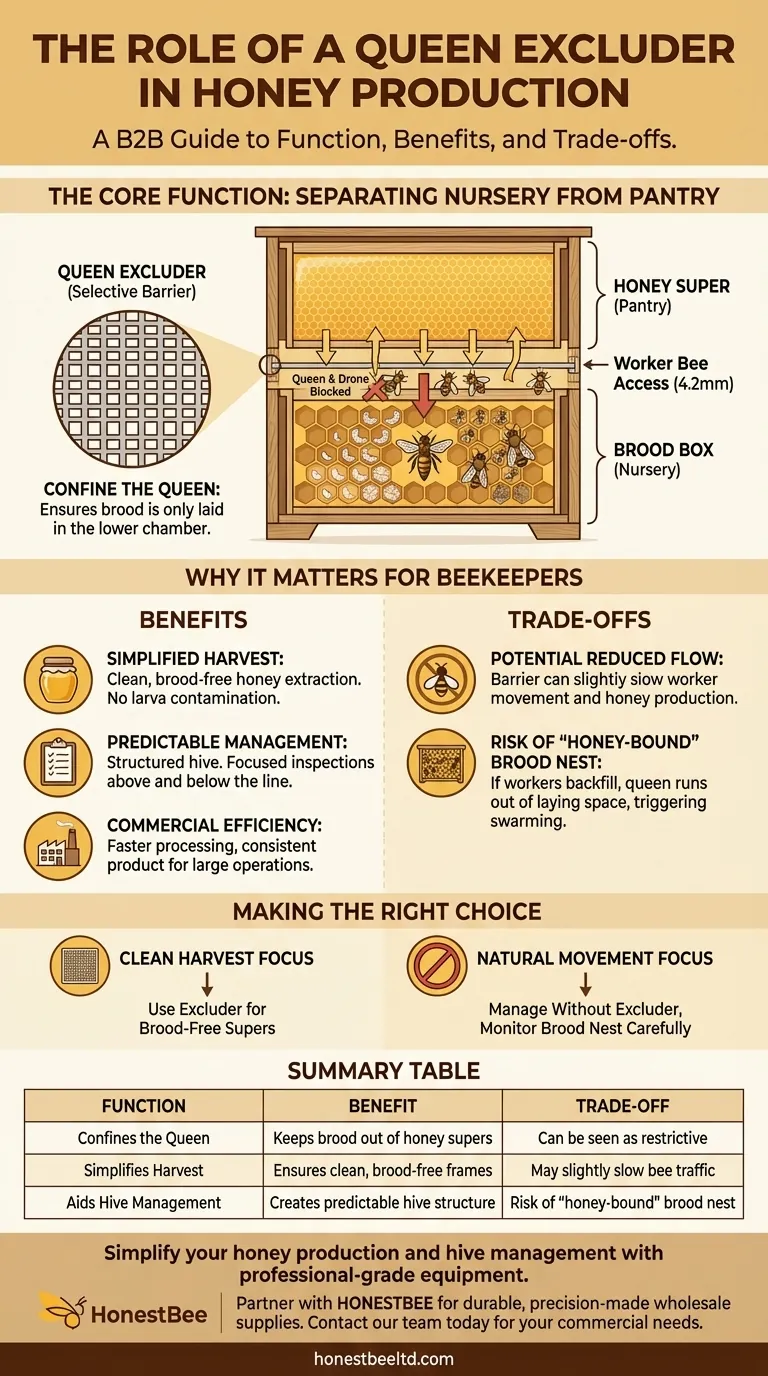At its core, a queen excluder serves a single, critical function when adding a honey super. It is a selective barrier placed between the brood boxes (the hive's nursery) and the honey supers (the pantry). This barrier is designed with gaps large enough for worker bees to pass through but too small for the larger queen bee, preventing her from laying eggs in the frames designated for honey collection.
The decision to use a queen excluder is a fundamental choice in beekeeping. It pits the goal of a clean, simple honey harvest against the potential for restricting the natural expansion and workflow of the colony.

The Core Function: Separating the Nursery from the Pantry
A queen excluder is a simple but precise tool. By creating a physical separation that only worker bees can cross, it enforces a strict division of labor within the hive's physical space.
What is a Queen Excluder?
A queen excluder is a flat grid or screen made of wire or plastic. The openings are carefully sized—typically around 4.2 millimeters—to be passable by worker bees but impassable for the larger-bodied queen and drones.
The Primary Goal: Confining the Queen
The sole purpose of this tool is to keep the queen in the lower sections of the hive, known as the brood chamber or brood boxes. This is where she lays eggs and raises new bees (brood).
The Result: Brood-Free Honey Supers
By blocking the queen's access to the upper honey supers, you ensure those frames are used exclusively for storing honey. This prevents the queen from creating a "chimney" of brood that extends up into your honey frames.
Why This Separation Matters for Beekeepers
Confining the queen and brood might seem restrictive, but it solves several practical challenges, particularly for those focused on honey production.
Simplified Honey Harvesting
When a super contains only honey, the process of extraction is clean and straightforward. You do not have to worry about damaging bee larvae or pupae, nor do you risk contaminating your final honey product with brood.
Predictable Hive Management
Using an excluder creates a well-defined structure in the hive. You know that brood inspections happen "below the line" and honey management happens "above the line." This predictability can make hive inspections quicker and more focused.
A Key Tool for Commercial Operations
For commercial beekeepers, efficiency is paramount. The guarantee of brood-free honey frames allows for faster processing and a more consistent product, making the excluder a standard piece of equipment.
Understanding the Trade-offs: Is an Excluder Always Necessary?
Despite its benefits, the queen excluder is a subject of debate, and less than half of beekeepers use one. The decision comes with important considerations.
The Argument Against: Potential for Reduced Honey Flow
Some beekeepers believe the barrier can slow down worker bees as they move between the brood nest and the supers. This traffic jam effect may slightly reduce the overall efficiency of honey production, leading some to call it a "honey excluder."
The Risk of a "Honey-Bound" Brood Nest
If the workers fill any empty cells in the brood box with honey, the queen can run out of space to lay her eggs. This condition, known as being "honey-bound," can restrict colony growth and is a primary trigger for the hive to swarm.
The Natural Beekeeping Perspective
Many hobbyists prefer to manage their hives without an excluder. They allow the queen to move freely, creating a more natural brood nest pattern. This requires more careful management during harvest, as the beekeeper must select only frames that are free of brood.
Making the Right Choice for Your Hive
The decision to use a queen excluder depends entirely on your goals and beekeeping style.
- If your primary focus is clean, straightforward honey harvesting: Use a queen excluder to guarantee your supers are brood-free and simplify the extraction process.
- If your primary focus is a more natural hive environment and maximizing bee movement: Consider managing your hive without an excluder, but be prepared to carefully manage the brood nest to prevent swarming and select honey frames carefully.
Ultimately, understanding the function and trade-offs of a queen excluder empowers you to manage your hive in a way that best aligns with your personal beekeeping philosophy.
Summary Table:
| Function | Benefit | Trade-off |
|---|---|---|
| Confines the Queen | Keeps brood out of honey supers | Can be seen as restrictive |
| Simplifies Harvest | Ensures clean, brood-free honey frames | May slightly slow bee traffic |
| Aids Hive Management | Creates predictable hive structure | Risk of a 'honey-bound' brood nest |
Simplify your honey production and hive management with professional-grade equipment from HONESTBEE.
Whether you're a commercial apiary focused on maximum efficiency or a distributor supplying the beekeeping market, the right tools are essential for success. A queen excluder is a key component for ensuring clean, brood-free honey supers and a predictable hive structure.
At HONESTBEE, we supply durable, precision-made beekeeping supplies and equipment through our wholesale-focused operations. Let us help you equip your operation for a more productive season.
Contact our wholesale team today to discuss your equipment needs and streamline your beekeeping process.
Visual Guide

Related Products
- Professional Plastic Queen Excluder for Modern Beekeeping
- Premium Wood Framed Metal Wire Queen Bee Excluder
- Wooden Queen Bee Excluder for Beekeeping
- Plastic Queen Bee Excluder for Bee Hive Wholesale
- High Performance Plastic Queen Excluder for Beekeeping and Apiary Management
People Also Ask
- Why are queen excluders recommended for Flow Hives? Prevent Brood Damage for a Clean Harvest
- What is the purpose of a queen excluder when adding a super? Streamline Your Honey Harvest
- How do queen excluders work in terms of spacing and bee movement? A Guide to Precision Hive Management
- What is a Queen Excluder and how does it work? Achieve Purer Honey & Better Hive Control
- What are the main advantages of using a queen excluder in beekeeping? Simplify Hive Management & Harvest



















